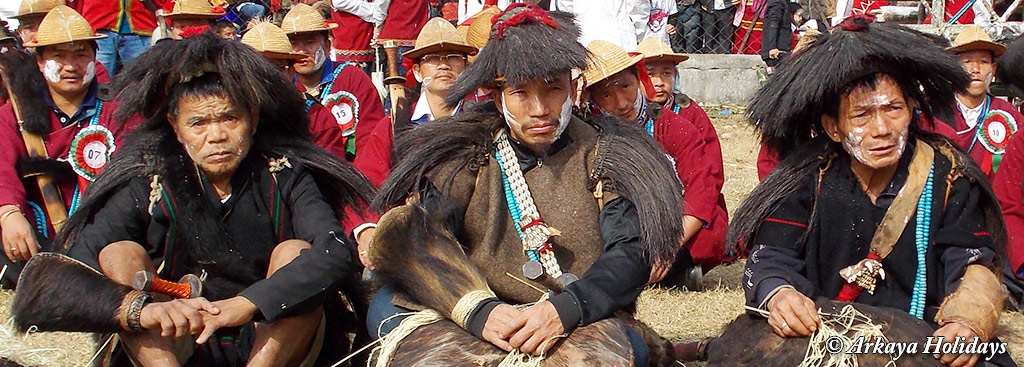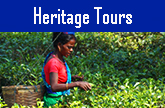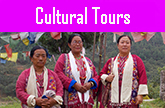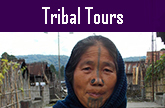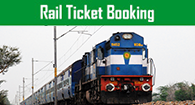North East India Tribal Tour
Tour Duration : 18 Nights / 19 Days
Travel Season : September to May
north east india tribal tour itinerary:
Day 01: Guwahati - Tezpur (166 kms, 4 hrs drive)
Meet upon arrival at Guwahati Airport / Railway Station.
Guwahati:
Guwahati, 'the city of Eastern light' stands on the southern bank of the mighty river Brahmaputra. It is the capital city of Assam and the gateway to the entire north-eastern states. Modern Guwahati is the hub city of Assam. It fulfills every aspect of a metropolitan city with its advanced means of transport, communication and media, as a major center of business activity, educational institutions, and various administrative and political activities of entire Assam. Besides, its landscape surrounded by hills and the mighty Brahmaputra River, rich and diverse flora and fauna enhances its natural scenic beauty.
If time permits, visit in Guwahati -
Kamakhya Temple:
Kamakhya Temple, one of the greatest 'Shaktipeeth', the shakti shrine of Goddess Kamakhya is situated on the Nilachal Hills. It is the oldest center of Tantric Shaktism. A famous legend regarding the birth of the Kamakhya temple narrates that Lord Shiva, rage with anger at his wife Sati's death, wandered the entire earth carrying Sati's corpse. An organ of Sati fell here and eventually the place became a temple of worship in due course of time. The temple features various stone inscriptions, terracotta works, sculptures and idols of Ganesha and Chamundeswari which are worth mentioning. The famous 'Ambubachi Fair' is celebrated with great enthusiasm every year in mid-June in this temple and devotees from different parts of India throng into it for the special occasion.
Srimanta Sankardev Kalakshetra:
Sankardev Kalakshetra is named after the most illustrious son and Vaishnavite propagator of Assam. It is the hub of all the cultural activities of entire Assam and a center for the promotion and preservation of the cultural heritage of the various tribes, communities and ethnic groups of Assam. It consists of a museum wherein lies the various traditional dresses, jewelry, ancient pottery, weapons belonging to various ethnic groups, sculpture, and works of art created by various artists depicting as a whole the entire Assam. The open air amphitheatre, wherein the cultural performances are held very often and the collection of whole life activities of the legendary artist Dr. Bhupen Hazarika carry a great measure in Kalakshetra.
Later, take transfer to Tezpur.
Tezpur:
Tezpur, the 'city of love' is situated on the northern bank of the Brahmaputra River. The ancient name of Tezpur was Sonitpur, the kingdom of the mighty legendary king, Baan Raja. It was the capital city under his reign. Tezpur holds in its heart many ancient historical events, and witnessed many legends and mythological wars of ancient Assam. The occurrence of a famous war named 'Hari-Hara' is related with the attainment of the present day Tezpur. This battle led to the bloodshed of so many soldiers that the entire place was stained with blood and hence the city came to be known as Tezpur ('Tez' meaning blood and 'pur' meaning city in Assamese language). Present day Tezpur was founded by the British colonial administration in 1835 as the headquarters of Darrang district.
Arrive at Tezpur, check-in at hotel. Later, visit at Tezpur -
Agnigarh:
Legend speaks of Agnigarh as a fortress built by Baan Raja in order to keep his daughter in isolation. The word 'Agnigarh' is a derivation of two Sanskrit words: 'Agni' meaning 'fire' and 'garh' meaning 'fort'. Situated on the north bank of the Brahmaputra River, it maintains its gracefulness with its lush green landscapes of the river. Nowadays, magnificent works of sculpture are depicted referring to the love story of Usha-Aniruddha and Great War 'Hari-Hara Juddha'.
Mahavoirab Temple:
Mahavoirab temple is the oldest Shiva shrine, where the second biggest Shiva linga of the world is worshipped. The temple was built by King Baan, the ruler of Sonitpur in 10th century. King Baan's daughter Princess Usha was a devotee of Lord Shiva and visited the temple for daily worship. Thousands of devotees gather during Shivaratri every year to offer prayers in this temple.
Evening: Free at leisure. Overnight: Stay in hotel.
Day 02: Tezpur - Itanagar (160 kms, 4 hrs drive)
In the morning after breakfast, take transfer to Itanagar. En-route visit -
Naagsankar Temple:
There are many beliefs prevailing regarding the history of Naagsankar temple, a famous Shiva shrine located near Chotia. According to mythology, the powerful King Naagmatta (another name Arimatta), believed to be the son of river God Brahmaputra built the Naagsankar temple. Another belief states that King Naagsankar of Lohitya dynasty who ruled ancient Assam in 378 A.D. built this temple around 4th A.D. The renovation of the temple took place under the reign of Ahom King Su-Seng-Pha in 1480. The main attraction of the temple is a large pond adjacent to it inhabited by a wide variety of rare species of turtles and local fishes. Some turtles are believed to be around 100 years old. Being a Shiva shrine, Shivaratri is celebrated with great pomp and joy in this temple.
If permission granted, visit -
Tea Factory:
Visit a bought-leaf tea factory and witness processing of globally acclaimed Assam tea.
Later, visit on the way -
Monabari Tea Estate:
Monabarie Tea Estate in Biswanath Chariali District of Assam is the World Biggest Tea Garden and Asia's Largest Tea Estate.The tea estate is owned by the McLeod Russel India Limited, a part of Williamson Magor Group.The Tea Garden Covers the Tea plantation area of 1158 hectares out of 1400 hectare of the total granted area. This tea garden produced 3150 tons crop per year. The Tea garden's workforce population is 2718.The Tea garden Manufactures 100% CTC Tea with 'Reddish Bright ' Quality. (Tip : Stop for a while and have some clicks posing in the tea plantations.)
Later, arrive at Itanagar and check-in at hotel.
Itanagar:
The historic capital city of Arunachal Pradesh, Itanagar stands on the dawn lit Himalayan foothills. A home to the Nyishi tribes, this town is located in the very midst of the state surrounded by traditional and modern wood-crafted tribal houses. Itanagar fascinates tourists to its rich archaeological and religious sites and its magnificent display of tribal arts, crafts and textiles.
In Itanagar, visit -
Ita Fort:
This ‘fort of bricks’ is located at the midst of the Itanagar town. The construction of this fort dates back to 1360 to 1550 A.D. during the rule of the Jitari dynasty. The structure of this fort is not regular in arrangement. This huge fort was built with more than 80lakhs of bricks and 45 centimeters of stone. The length of the complete brickwork of the fort is estimated to be about 16,200 cubic meters. It consists of three entrance gates on its eastern, western and southern sides.
Ganga Lake:
Locally named as ‘Gekar Sinyi’, this natural lake is a delightful spot for picnic and boating experiences. It surrounds an area about 4 sq. km. and is a home to a number of birds. Standing on the foothills of the Himalayan range, the lake is encompassed by forests full of bamboo and fern trees, orchids and different types of vegetation.
Evening: Free at relaxation. Overnight: Stay in hotel.
Day 03: Itanagar - Ziro (110 kms, 4 hrs drive)
In the morning after breakfast, visit in Itanagar -
Buddhist temple:
The Buddhist temple is set within the premises of magnificent gardens located atop on a hill. The yellow roof of the temple displays a Tibetan touch along with a stupa established in front of the shrine. A tree planted by Dalai Lama beside this beautiful temple reflects his holy presence over the entire place.
Jawaharlal Nehru State Museum:
The Jawaharlal Nehru State Museum reflects the rich tribal heritage of Arunachal Pradesh. It displays various handicrafts and archaeological remains, textiles, musical instruments, wood carvings, weapons of the past ages. It showcases a unique collection of ancient art and craft, jewellery, variety of tribal headgears etc. A library and a handicraft workshop centre dealing in traditional cane manufacture are also present here.
Later, drive to Ziro.
Ziro:
A remarkable plateau and the abode of the Apatani people, Ziro set at a high altitude is renowned for its pine and bamboo grooves, Tarin, the high altitude fish farm, exotic landscape with a delightful view of sunrise from the hilltops, tribal culture and a centre of crafts such as cane and bamboo products. It is a perfect spot for adventure enthusiasts, offering endless experience for trekkers and hikers.
Arrive at Ziro and check-in hotel.
Evening: Free at relaxation. Overnight: Stay in hotel.
Day 04: Ziro
In the morning after breakfast, visit at Ziro -
Apatani tribal villages:
Hong, Hari, Hija, Duta, Bula, Tajang, Bamin Michi and Mudang Tage are eight distinctive Apatani villages situated at Ziro valley. Visit Hong village, the largest village of Apatani plateau and other Apatani villages as well. There are more than 5,000 people living in 700 houses at Hong village. In every village, there are some male community halls called 'Lapang'. Apatani people are famous for tattoo on their forehead and nose plug. Basically, Apatani people are animist who worship all natural gods. Donyi-Polo, i.e, the Sun and Moon is their supreme God. Apatani people are known for paddy cum pisciculture. They celebrate Myoko festival in the month of March for the welfare of their community and Dree festival in July for bountiful harvest, community well being and to keep away the pest.
Shiva Lingam:
The calm hills of Kardo hold one of the largest Shivalinga with a height measuring 25 feet and 22 feet in circumference. The Shivalinga excavated in the recent past is located near Hapoli town.
District Museum:
The District Museum at Zero exhibits a variety of handicrafts and textiles, musical instruments, weapons of the past ages used by different tribes and sub-tribes of Arunachal Pradesh. It displays an exclusive collection of art and craft, jewellery, variety of tribal headgears etc reflecting the traditions of ancient tribal culture.
Craft Center:
Craft Center showcases the unique crafts and handloom products of the Apatani tribe. A wide selection of craftsmanship is displayed in carpet weaving (woolen carpets) and traditional cloths exhibiting a tribal influence.
Regional High Altitude Fish Seed Farm:
Regional High Altitude Fish Seed Farm located at Tarin is a unique reflection of paddy and fish cultivation practiced by the Apatani tribe. The cultivation is carried out encompassing an area of 200 kilometers in Kamala valley. Tourists flock in this high altitude farm to view the distinctive farming covered by pine and bamboo grooves.
Overnight: Stay in hotel.
Day 05: Ziro - Daporizo (170 kms, 6 hrs drive)
In the early morning after breakfast, take transfer to Daporizo. En-route visit -
Nyishi tribal village:
The main community of Raka village is Nyishi tribal people. Nyishi people are also called as 'Nyashang' meaning people of the land. Folk tales and oral literature narrates the Nyishis to be the migrants from Tang Sampo valley of Tibet. Abotani was the earliest ancestor of this tribe. The source of livelihood of this tribe is agriculture, mainly Jhum cultivation. Initially, polygamy was practiced by the Nyishi people, but it is less observed in recent times. The Nyishis celebrate 'Nyokum', a festival honouring their ancestors.
Hill Miri tribal village:
The inhabitants of both Raga and Dokum villages are Hill Miri tribes - one of the sub tribe of Nyishi people. Claiming to be the descendents of Abotani, Hill Miri tribe is believed to be the migrants of Ane Saingik Nite. They comprise a small population of less than 10,000 people in this planet. Hill Miri people are good hunters. They speak the Hill Miri language or sarak, which is a form of Tibetan-Burman language family.
Later,drive to Daporizo.
Daporizo:
Located on the right bank of the Subansiri River, Daporizo is a small town set along remarkable villages and beautiful caves. The residing population here speaks languages such as Tagin, Hill Miri, Adi, Assamese, Hindi and English. Suspension bridges carved out of bamboo and cane over the Subansiri River are great attraction to tourists. Daporizo is also famous for its picnic spot.
Arrive at Daporizo and check-in tourist lodge / hotel.
Later, visit -
Tagin tribal village:
The inhabitants of Ligu village are Tagin and Hill Miri tribal people. Tagin tribe is regarded to be the migrants of Penji, a village in Tibet. They are believed to be the descendants of Abotani. The Tagins are the supporters of Donyi-Polo, whereas the Naa and Mra (two groups of Tagin) are strong followers of Tibetan Buddhism. Si-Donyi is an important festival of this tribe celebrated to honour the Earth and the Sun.
Overnight: Stay in tourist lodge / hotel.
Day 06: Daporizo - Along (160 kms, 6 hrs drive)
In the morning after breakfast, visit at Daporijo -
Tagin tribal village:
Shikarizo, one beautiful village in Daporizo is resided by only Tagin tribal people. Tagin tribe is regarded to be the migrants of Penji, a village in Tibet. They are believed to be the descendants of Abotani. The Tagins are the supporters of Donyi-Polo, whereas the Naa and Mra (two groups of Tagin) are strong followers of Tibetan Buddhism. Si-Donyi is an important festival of this tribe celebrated to honour the Earth and the Sun.
Menga Cave:
Menga cave is a magnificent natural cave honoured to Lord Shiva. Visitors are attracted in large numbers to this popular place of worship. Devotees gather in large numbers during Makar Sankranti and Shivaratri festivals.
Then take transfer to Along. En-route visit -
Galong tribal village:
Bararupak village is inhabited by Galong tribe. One of the most populous tribe of the state, the Galong tribe reside in West Siang, south western side of East Siang, south eastern side of Upper Subansiri and in some small areas in Lower Dibang Valley and Changlang districts of Arunachal Pradesh. Both monogamy and polygamy is prevalent in this tribe following a patriarchal system of society. The base of economy of this tribe is agriculture. Initially, shifting cultivation was practiced by Galong people, but at present Wet Rice and terrace cultivation dominates the agricultural scenario. Although Galong is spoken by 95% of the population, people also speak Assamese, Hindi and English language.
Later, drive to Along.
Along:
Set on the south bank of river Siyom at an altitude of 300 meter above sea level, Along (locally called as Aalo) small town, covered with scenic natural surroundings, serves as a suitable site for holidaying during the summer months and adventure sports like trekking, hiking and angling as well.
Arrive at Along and check-in hotel.
Evening: Free at relaxation. Overnight: Stay in hotel.
Day 07: Along
In the morning after breakfast, take a full day excursion of Along visiting -
Donyi-Polo Temple:
Established in 1972, Donyi-Polo temple at Along is a religious center of the followers of Donyi-Polo religion. Out of 400 community centers in Arunachal Pradesh, it is designated to be the only worshipping centre of Donyi-Polo religion in the entire state. The religion possesses no written scriptures. The rituals and traditions have been orally passed from ancestors to the next generations. There is a belief among Donyi-Polo animists of a common lineage of all the people of Arunachal Pradesh as the descendants of Abotani. The rituals of this religion include invoking of the spirit and nature along with holy sacrifices to the spirits. The Donyi-Polo temple acts as a centre of worshipping objects of nature, the Sun and the Moon. The temple premises consist of a community hall, a meditation room and a prayer hall.
Galong tribal villages:
The inhabitants of Kabu, Pobdi and Paya villages are Galong tribal people. Both monogamy and polygamy is prevalent in this tribe following a patriarchal system of society. The base of economy of this tribe is agriculture. Initially, shifting cultivation was practised by Galong people, but at present wet rice and terrace cultivation dominates the agricultural scenario. Even though Galong language is spoken by 95% of their total population, people also speak Assamese, Hindi and English language.
Suspension Bridge:
The Suspension Bridge on the Siang River is another tourist attraction worth watching. It is made of local cane and bamboo which exhibits superb skills of the local tribal people. The bridge is approximately 60 to 70 meters long, connecting to the other hill tribes of nearby areas. Fishing in Siang river near the bridge is a favourite pastime of the locals.
Ramkrishna Mission:
The joint efforts and initiative of Govt. of India and the mission authorities at Belur Math led to the establishment of a school at Along in 1966. Started with an enrolment of only 35 students in a thatched building, the school gradually introduced in its curriculum vocational courses on tailoring, carpentry, industrial workshop, computer training etc. It also opened up a printing press and included accessories such as dairy farm, poultry farm and an agricultural field within the school campus. The school, providing co-education has increased its student population to a number of 2241 with a hostel facility of 260 tribal boys only. Apart from providing formal education and academic excellence among the students, the mission aims at the overall development of the students including moral education, health education, vocational training to prepare them for self sufficiency in their future lives.
Later, visit the local market at Along.
Evening: Enjoy a cultural show of Erap dance (warrior dance of Galong tribe) or Ponu dance (of Galong tribe) or Tapi dance (of Adi- Minyong tribe) along with an ethnic feast. (Optional)
Overnight: Stay in hotel.
Day 08: Along - Pasighat (130 kms, 6 hrs drive)
In the morning after breakfast, take transfer to Pasighat. En-route visit -
Confluence of Siang and Siyom:
Have a look into the scenic beauty of confluence of two rivers - Siang and Siyom. The source of Siang River is Talung Tso Lake in south-western part of Tibet. This trans-boundary river is named as Yarlung Tsangpo in Tibet, Siang in Arunachal Pradesh, Brahmaputra in Assam and Jamuna in Bangladesh.
Komsing:
Drive further to visit -
Adi Minyong tribal village:
The inhabitants of Pangin village are Adi Minyong tribal people. Minyong, Padam and Passi are the sub tribes of Adi. They practice both terrace farming and shifting cultivation. Solung is the main festival of Adi tribe celebrated during the 1st week of September every year. Adi people have a community hall called Dere where children of different age group gather to learn about social norms from elderly citizens.
Kekar Monying:
Later drive to Pasighat.
Pasighat:
One of the oldest towns of Arunachal Pradesh and the homeland of the Adi tribe, Pasighat, set on the bank of river Siang is surrounded by snow-covered peaks and rocky mountain. It supports a wild variety of flora and fauna. Adventure sports like trekking and hiking, river rafting, boating and angling on the Siang river call for an exciting trip to this place.
Arrive at Pasighat and check-in hotel. Overnight: Stay in hotel.
Day 09: Pasighat
In the morning after breakfast, take an excursion to Adi Padam and Idu Mishmi tribal villages.
Adi Padam tribal village:
The inhabitants of Mebo village are Adi Padam tribal people. Padam, Passi and Minyong are the sub tribes of Adi tribe.
Idu Mishmi tribal village:
The inhabitants of Aohali village are Adi Padam tribal people.
Later, return to Pasighat. Overnight: Stay in hotel.
Day 10: Pasighat - Sivasagar (205 kms, 4 hrs drive)
In the morning after breakfast, take transfer to Sivasagar. En-route cross - the mighty Brahmaputra River through newly built Bogibeel bridge.
Arrive at Sivasagar and check-in hotel.
Sivasagar:
Literally, the name 'Sivasagar' means 'Ocean of Lord Shiva'. This historical city of Assam remained the capital seat of the mighty Ahoms who ruled over Assam for nearly 600 years till the arrival of the British. It reflects the glory of ancient Assam under the Ahom rule. The Ahom monarchs started the tradition of building royal palaces, tanks, roads, forts, temples, towns, embankments, bridges of stones and bricks all over the kingdom. Apart from representing a number of monuments of rare historical and archaeological significance, modern Sivasagar has grown as a fast developing town with leading oil and tea producing areas.
At Sivasagar, visit -
Shiva Dole:
This famous Shiva temple was built by the second queen of Shiva Singha, Queen Ambika in 1734 AD. It is reputed to be the tallest Shiva Temple in India with a height of 180 feet and 195 feet in diameter caped by seven feet height golden dome.
Sivasagar Tank (Barpukhuri):
The famous Sivasagar tank was dug in 1734 AD by Queen Ambika, the second queen of King Shiva Singha to honor the memory of her husband. The tank covers an area of 129 acres of land. The water level of the tank remains always above the level of the town and never changes. Due to its big size and depth, it is regarded as 'Sagar' meaning 'sea'.
Rang Ghar:
Rang Ghar is a historic amphitheatre constructed during the rule of Ahom king Pramatta Singha in 1746AD. During those times, Rang Ghar acted as a royal pavilion where the Ahom royalties and officers witnessed several outdoor games such as wrestling, buffalo-fight, falconry, elephant fights and other sporting and cultural events. It is an antique oval-shaped two storied building. The ground floor is rectangular in shape with two trapezoidal ends. Due to its typical and special structure, it has become a symbol of modern Assam.
Tolatol Ghar:
Tolatol Ghar was originally constructed by Ahom King Rudra Singha in 1699AD. Several changes and additions were made by the later Ahom rulers and this palace got its present structure of bricks and indigenous type of cement during 1751-1769AD under Ahom king Rajeshwar Singha. It is a seven storied palace of which four stories are above ground and the remaining three stories are underground with two underground tunnels, one leading to Dikhow River and the other to Gorgaon Palace at Nazira. It was also once the capital and military station of the Ahom kings.
Evening: Free at relaxation. Overnight: Stay in hotel.
Day 11: Sivasagar - Mon (93 kms, 3 hrs drive)
In the morning after breakfast, take transfer to Mon.
Mon:
Mon is the homeland of the former head hunters, the Konyak Nagas. They are well equipped with the skill of craftsmanship in wood carvings, guns, gunpowder, headgears and metal ornaments. The presence of semi traditional villages and tattooed warriors in loin cloths is the famous attraction of Mon.
Arrive at Mon and check-in guest house.
Later, visit at Mon -
Mon village:
Overnight: Stay in guest house.
Day 12: Mon
In the morning after breakfast, visit at Mon -
Shangnyu village:
Shangnyu village, considered as one of the prominent villages in Mon district is ruled by the Chief Angh. History speaks of amiable relationship between Shangnyu and Angh kings. The responsibility of collection of taxes rested on the Shangnyu Angh. Their collection areas used to comprise of villages starting from Sivasagar in Assam to the Wanchos in Arunachal Pradesh. The main attraction of this village is a huge and unique piece of wood carving of the metallic age measuring ……………… , placed in a concrete museum at the entrance of the Angh’s house. This wonderful wooden monument engraved in human and other creature’s carving is about 500 or 600 years old and is believed to be constructed by two brothers with the help of heavenly spirits.
Afternoon visit -
Chui village:
Overnight: Stay in guest house.
Day 13: Mon - Longwa - Mon (44 kms one way, 2 hrs drive)
In the morning after breakfast, take an excursion of Mon to visit -
Longwa village:
Return to Mon.
Overnight: Stay in guest house.
Day 14: Mon - Jorhat - Mokokchung (260 kms, 8 hrs drive)
In the early morning after breakfast, take transfer to Mokokchung via Jorhat. En-route stop -
Jorhat:
Jorhat is known as one of the leading towns of Assam and the centre of tea industry. The earlier Jorhat town was sought to ruins as a result of the Burmese invasions in 1817 AD. But as the British ventured into Assam in 1824 AD, these invasions were cleared out under the British administrative officers, David Scott and Captain Richard. Present day Jorhat is the hometown of the world famous Tocklai Tea Research Center, Assam Agricultural University, North-East Institute of Science & Technology and the head office of Assam Sahitya Sabha. There are about 140 tea gardens in and around Jorhat.
If time permits, visit –
Tocklai Tea Research Institute:
The Tocklai Tea Research Institute, previously known as Tocklai Experimental Station is the oldest and largest research institute of its kind in the world. It was established in 1911 AD. It carries out all research projects at national level on all aspects of tea cultivation and processing. It encompasses a large network covering South Bank, North Bank, Upper Assam, Cachar, Darjeeling and Terai. This research station has contributed largely in the increase of tea production which greatly adds to the economy of India. Recent data states that total clone species of tea derived in Tocklai Tea Research Institute numbers to 31. Till date, the institute has succeeded in inventing total number of 213 tea species. Through the effort of the Scientists involved in various tea research projects, 14 numbers of tea seeds have been invented in this institute.
Later, drive further to Mokokchung.
Mokokchung:
Arrive at Mokokchung and check-in hotel.
Overnight: Stay in hotel.
Day 15: Mokokchung
In the morning after breakfast, take an excursion tour of Mokokchung visiting -
Mopungchuket village:
Mopungchuket village is the homeland of the Aao Nagas. Beautiful traditional communal Naga houses named as Morung are found here. The inhabitants of the village are visitor-friendly and hospitable. This tribe celebrates numerous harvest festivals each year.
Ungma Village:
History narrates that Ungma village was founded by the Ao Naga tribe when they entered the terrain for the first time from their ancestral home at Chungliyimti. Ungma village is the desired destination of tourists interested in unique folklore, customs and traditions. It is the oldest and largest of all the Ao Naga villages and the second largest village in Nagaland next to Bara Basti or Kohima village. The homeland of the Ao Nagas, Ungma village has nurtured the rich Ao culture and traditions which is still prevalent among the villagers.
Evening: Free at relaxation. Overnight: Stay in hotel.
Day 16: Mokokchung - Kohima (150 kms, 3 hrs drive)
In the morning after breakfast, take transfer to Kohima. En-route visit -
Longkhum village:
Shrouded in full-bloomed Rhododendrons around the hillocks, Longkhum village is famous for exquisite ethnic handlooms and handicrafts. The village dwellers follow an animist religion called ................. and worship a God called Longlanpa Tsungrem.
Wokha:
The term ‘Wokha’ literally means census. Wokha is the homeland of the Lotha tribe as well as the district headquarters of Lothas, set amidst terraced fields, blooming bright flowers and picturesque surroundings. This village is highly acclaimed for its fertilizer and pesticide free cultivation of oranges and pineapples. The main attractions are the presence of ancient stone monoliths, constructed by tribal elders. Lothas are known for their colourful dances and songs.
Longsa Village:
Lotha tribe
Tseminyu village:
Rengma tribe
Tuophema Tourist Village:
An Angami Naga village, Tuophema tourist village was set in 1431, initially named after the 'Erithrina' tree. There was a belief among the villagers regarding the holy presence of the tree which they believed would make them victorious. Renowned as an eco tourist village, it is regarded as a model village under the Village Development Board covered by lovely cottages due to the proper execution of the village development programmes. Besides, The Nagaland Tourism Department has selected this village for the celebration of the Angami - Naga Sekrenyi festival celebrated during 25th - 27th February every year.
Later, take transfer to Kohima.
Kohima:
The capital city of Nagaland, situated at an altitude of 4738 feet above mean sea level is encompassed by hills providing a majestic beauty to the city. The name 'Kohima' has been derived from Tenyidie dialect 'Kewheimia' meaning "people living in the hills". Kohima received its present name from the British rulers who had set up colonial units devastated during the Second World War. Kohima city is inhabited by the Angami, Rengma, Kuki and Zeliang Naga tribes. It is a beautiful hill station of North-East India beckoning the tourists to its religious, monumental and village attractions.
Arrive at Kohima and check-in hotel.
Overnight: Stay in hotel.
Day 17: Kohima
In the morning after breakfast, visit in and around Kohima -
Kisama Village:
Kohima village:
Kohima village, also known as Bara Basti is considered as the second largest village in Asia. It is also one of the most densely populated villages in the continent. Legend narrates that the village was set up by a man called Whinuo Kewhira. Kohima village is grouped into 4 khels namely Dapfutsuma, Lhisema, Pfuchatsuma and Tsutsonuoma. Several clans are brought together within the village community by the institution called 'khel' which governs the entire village. The membership of a khel depends on two aspects - birth or heredity. The ancient Kohima village was believed to possess 7 lakes along with 7 gateways. The main entrance of the village is set with a traditional wooden gate carved in traditional Naga art and decorated with horns of gayal (mithun) reflecting the glory of the ancestors of the village.
Catholic Cathedral:
The Catholic Cathedral standing on the Aradurah Hill is acclaimed as the largest cathedral in entire Asia. The birth of this cathedral took place after the battle of Kohima in the Second World War. It was established with an aim to offer prayers in loving memory of the sacrificed soldiers by Japanese survivors of the war. The cathedral covers a huge area of 25,000 sq feet showcasing a mixture of both modern and native architectural treat.
Kohima War Cemetary:
It is a war memorial set in the honour of those valorous soldiers and officers who sacrificed themselves during the Second World War. The cemetery, earlier known as 'Garrison Hill' is maintained by the Commonwealth War Graves Commission. Sir Edwin Lutyens was the principal architect of this cemetery. There stand 1421 magnificent stone graves of the brave soldiers killed in the battle of Kohima in April, 1944. Of these, 1070 graves are of soldiers from United Kingdom, 5 Canadian soldiers, 3 Australian soldiers, 33 graves of undivided India, 2 graves of East African soldiers, 1 from West Africa, 9 Burmese soldiers and a single non-war grave. Each grave bears an appropriate epitaph engraved in bronze. Historians regard the Battle of Kohima as "one of the bitterly fought battles of the Second World War". The British before departing Kohima had erected a heart touching inscription inside the memorial in the memory of brave comrades which reads: "When you go home, tell them of us and say: FOR YOUR TOMORROW, WE GAVE OUR TODAY."
Sales Emporium:
The Sales Emporium houses a wide collection of Naga handloom and handicraft items. Such handloom articles are also available in private outlets such as Gurtal (near war cemetery) and Belho Weavers (beside Assam Oil Company).
Overnight: Stay in hotel.
Day 18: Kohima - Dimapur (72 kms, 1 & 1/2 hrs drive)
In the early morning after breakfast, take transfer to Khonoma Green Village.
Later, drive further to Khonoma Green village.
Khonoma Green Village:
Khonoma village is the homeland of the Angami tribe. This 700 year old village also referred to as 'Khwunoria' by the inhabitants holds a historical record of a brave resistance made by the Naga warriors against the British in 1879 AD. The presence of a fort called 'Kuda', meaning "a place of defense" is a unique feature of this village. The villagers practice terrace farming of Alder trees which exhibits their skill in management of terraced cultivation. This farming fixes nitrogen in the soil which controls soil erosion. This step towards 'eco-tourism' has heightened the mission of "Green Khonoma" in the village.
Later, take transfer to Dimapur.
Dimapur:
Dimapur, the gateway of Nagaland is designated to be the largest city in Nagaland, popularly known as the "City of River People". 'Dimapur' is a derivation from Kachari dialect in which 'di' implies river, 'ma' meaning great and 'pur' means city, together meaning "the city near the great river". This city, situated at an altitude of 475 feet above mean sea level is the most developed and industrialized area of the state.
Arrive at Dimapur and check-in hotel.
Overnight: Stay in hotel.
Day 19: Dimapur departure
In the morning after breakfast, visit at Dimapur -
Medieval Ruins of Kachari Kingdom:
Dimapur holds the status of being the ancient capital of Kachari tribe who ruled the state before 13th century. The glory of the Kachari kingdom appears on the ruins spread around Dimapur. The ruins provide evidences of the Kachari civilization reflecting a touch of Hinduism who were pre-dominantly non-Aryans.
Diezephe Craft Village:
The village exhibits trained weavers and craftsmen skilled in wood carvings, bamboo and cane works. In recent times, the village has developed in this field of art expanding the variety of handloom and cane products with the assistance of Nagaland Handloom and Handicrafts Development Limited.
North East Zone Cultural Centre Museum:
This cultural centre set in a well conditioned museum organizes various cultural programs in and outside the state. Centre aims at the cultural promotion of the state and provides ample scope for tourists desiring to gain knowledge and information about the various cultural heritages of North Eastern people.
Later, take transfer to Dimapur airport for your onward destination.
Tour terminates here
North East India Tourism
Package Inclusions:
# All ground transportation by a comfortable vehicle driven by dedicated driver
Package Exclusions:
# Any air fare or train fare







